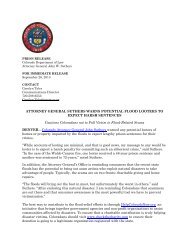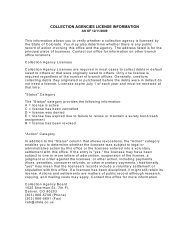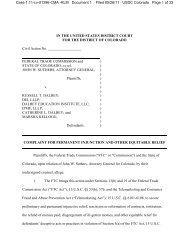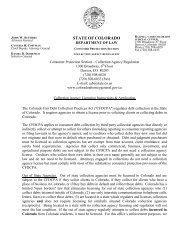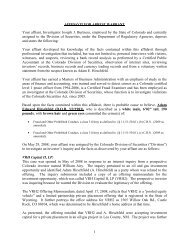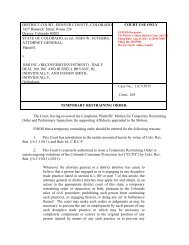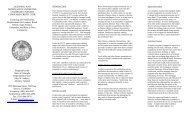brief in opposition to motion to dismiss - Colorado Attorney General
brief in opposition to motion to dismiss - Colorado Attorney General
brief in opposition to motion to dismiss - Colorado Attorney General
You also want an ePaper? Increase the reach of your titles
YUMPU automatically turns print PDFs into web optimized ePapers that Google loves.
no recourse <strong>to</strong> the courts <strong>to</strong> protect those rights. Defendants posit this argument on subjectmatter jurisdiction and nonjusticiability.As <strong>to</strong> the former, Defendants confound subject matter jurisdiction and nonjusticiability,fail<strong>in</strong>g <strong>to</strong> recognize the significant difference between the two. Powell v. McCormack, 395 U.S.486, 512 (1969); Baker v. Carr, 369 U.S. 186, 198 (1962). The district court and the <strong>Colorado</strong>Supreme Court pla<strong>in</strong>ly have jurisdiction <strong>to</strong> construe the state constitution. “Pursuant <strong>to</strong><strong>Colorado</strong> Constitution Article VI, section 1, the judicial branch of <strong>Colorado</strong> government isempowered <strong>to</strong> construe the constitution’s mean<strong>in</strong>g. . . . [T]he judiciary is the f<strong>in</strong>al arbiter of whatthe laws and the constitutions provide. Board of County Comm’rs v. Vail Associates, 19 P.3d1263, 1272 (Colo. 2001) (citations omitted). Indeed, “[o]nly the judicial branch holds theultimate authority <strong>to</strong> construe the constitution’s mean<strong>in</strong>g.” Wash<strong>in</strong>g<strong>to</strong>n County Bd. ofEqualization v. Petron Dev. Co., 109 P.3d 146, 149 (Colo. 2005).The <strong>Colorado</strong> Supreme Court has frequently exercised subject matter jurisdiction overEducation Clause claims. In Lujan v. <strong>Colorado</strong> State Bd. of Educ., 649 P.2d 1005 (Colo. 1982),the Court affirmed its function “<strong>to</strong> rule on the constitutionality of our state’s [school f<strong>in</strong>ance]system” and <strong>in</strong>terpreted the thorough and uniform provision not <strong>to</strong> “require that the <strong>General</strong>Assembly establish a central public school f<strong>in</strong>ance system restrict<strong>in</strong>g each school district <strong>to</strong>equal expenditures per student.” Id., 649 P.2d at 1025. The Lujan Court cited several cases <strong>in</strong>which it had previously construed the Education Clause. For example, <strong>in</strong> Marshall v. SchoolDist. RE #3 Morgan County, 191 Colo. 451, 553 P.2d 784 (1976), the Court held that theEducation Clause does not require school districts <strong>to</strong> provide students with free books. InFangman v. Moyers, 90 Colo. 308, 8 P.2d 762 (1932), the Court found that the Education Clauseassured the right of a child of a broken family <strong>to</strong> attend school <strong>in</strong> the district <strong>in</strong> which he resided14



